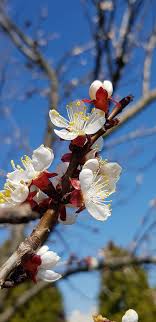March Update from the Community Garden

March Update from the Community Garden
If I were a better gardener, I could wax lyrical about the wonderful winter veg I’m picking – kale, leeks, winter mustards. In reality, there’s little to boast about, and nothing to pick in the SCG this month, bar some rhubarb, which would prefer to be left a little longer, and some spicy salads and land cress! What we do have in abundance is seedlings of every sort, which are being protected in the greenhouse until the risk of frost is reduced.
March has been a month of preparation – weeding, re-covering the paths with woodchip, mulching, coppicing some hazels to get poles and let light into the under-storey, and dividing and re-planting rhubarb crowns and peonies. We’ve also moved some bulbs around, which is easily done at this time of year, as you can actually see where they are! Snowdrops and aconites have a reputation for being best planted ‘in the green’, but the process works equally well for daffodils, crocuses, and alliums. For best results, wait until a little after flowering. It’s been hugely gratifying to see honeybees covering the crocuses that we planted a few years ago, in between the peonies. Spring bulbs and summer perennials make great couples, enabling you to get twice the impact from the same space – we have planted alliums and crocuses between the peonies, snowdrops and crocuses under the fruit bushes, and daffodils around the fruit trees and hazels.
We have planted a few fruit trees while they are dormant, thanks to a small grant from the Tree Council – plum ‘Czar’, apple ‘Howgate wonder’ and quince ‘Champion’ – let’s hope they live up to their names. We sprinkled their bare roots with mycorrhizal fungi, which should help the tree to create a wide-reaching underground network for water and mineral ions, and even, reputedly, for communication! Have a read of Merlin Sheldrake’s eye opening and well researched book ‘Entangled Life’ if this interests you. The trees also got a deep mulch of 1 year old woodchip to act as a water retaining blanket, as well as a nice cellulose-rich food for the fungi. Any tree needs watering for at least its first 2 (if not 5) summers after being transplanted, especially if we get the extreme dry periods that have characterised the last few years, and it really pays off to leave a grass-free collar with a radius of minimum 50cm round the trunk, especially if it is covered with a nice deep organic mulch such as compost, leafmould, or aged woodchip.
March has seen the completion of the water-catching roof and tank at the allotment site. Sincere thanks go to Simon Hammett, who has been both the brains and the braun behind this project, which has been funded by the Chess Smarter Water Catchment programme. This aims to bring about behavioural change and increase understanding around water use, as well as helping with projects that manage flow and increase biodiversity. Our structure should catch 3000-5000 litres of water each year, to be used on the community allotment.
Speaking of biodiversity, No-Mow May is not far away! Would you consider leaving your garden, or part of it, unmown,, in the interest of biodiversity? Insect numbers in the UK are down by 64% since 2004, largely due to the way that we farm and garden. Leaving lawns unmown allows the flowering plants that are growing in there to actually flower, providing pollen and nectar, and to set seed, providing yet more nutriment and the possibility of reproducing. Most lawns, though they look like just grass, are a mixture of species such as daisies, hawksbit, dandelion, bugle, buttercup and many different grasses. We may not love insects in their own right, but they are a lowly but vital part of the infinitely complex web of life on which we all ultimately depend. No Mow May has an excellent website if you want help or information.
As ever, get in touch if you’d like to be involved. Email is best – [email protected], or ask to join the SCG WhatsApp group
We use cookies to ensure that we give you the best experience on our website. If you continue to use this site we will assume that you are happy with it.Ok